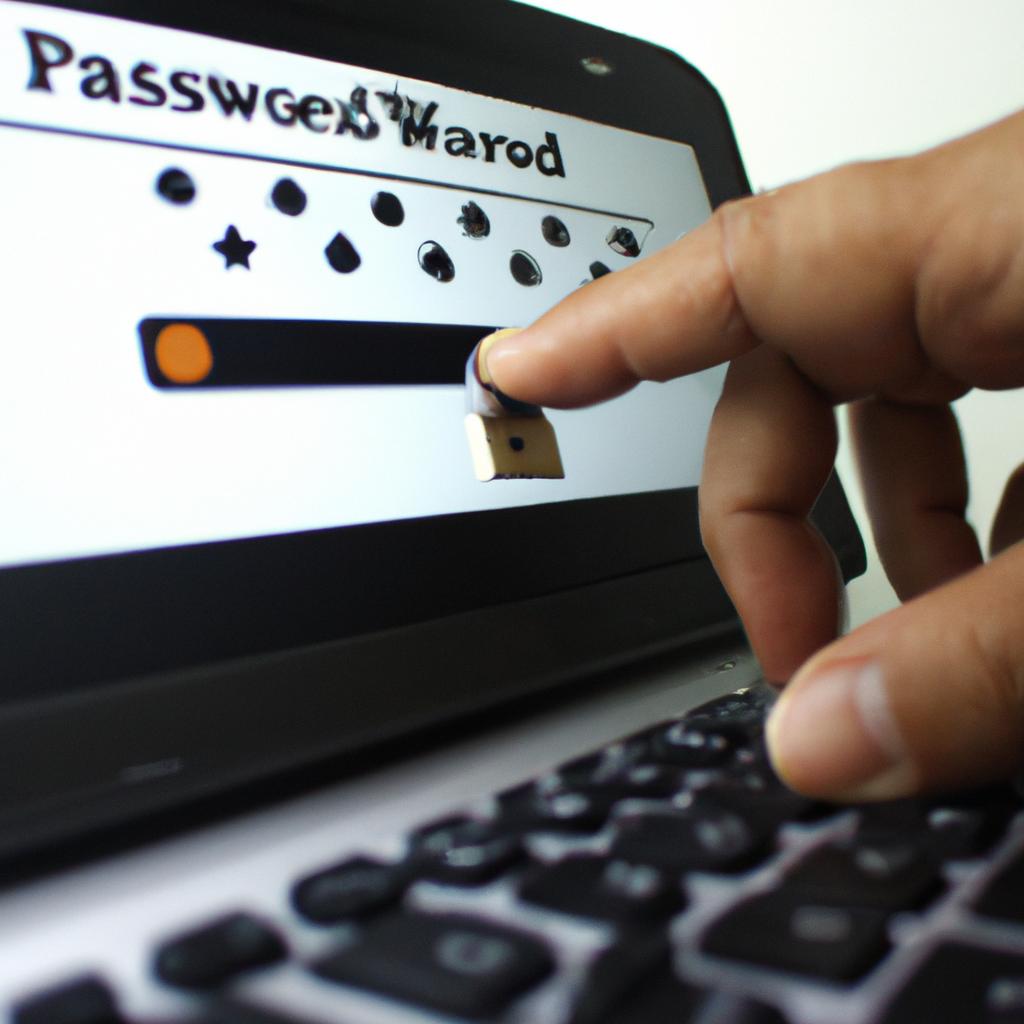Password policies play a crucial role in ensuring online security and protecting sensitive information. With the increasing prevalence of cyberattacks, organizations must prioritize effective password management to safeguard their systems and data. One notable example highlighting the significance of robust password policies is the 2014 Yahoo breach, where hackers gained access to over 500 million user accounts due to weak passwords. This incident underscores the need for organizations to implement stringent measures and educate users on creating strong passwords.
In today’s digital age, individuals rely heavily on online platforms for various activities such as banking, shopping, and communication. However, this increased reliance also exposes them to potential risks posed by malicious actors seeking unauthorized access. Weak or compromised passwords are often exploited by attackers as an entry point into computer networks and personal accounts. Therefore, implementing well-designed password policies is essential in mitigating these risks and maintaining secure online environments.
A comprehensive approach to password management includes several key elements: password complexity requirements, regular updates and changes, account lockouts after failed login attempts, multi-factor authentication options, and education about best practices for creating strong passwords. By adhering to these guidelines, both organizations and individual users can enhance their defenses against cyber threats while fostering a culture of cybersecurity awareness. In this article, we will explore the importance of each of these elements and provide practical tips for implementing effective password policies.
-
Password Complexity Requirements:
Password complexity refers to the use of a combination of uppercase and lowercase letters, numbers, and special characters in a password. By enforcing complexity requirements, organizations can ensure that passwords are harder to guess or crack through brute-force attacks. It is crucial to establish a minimum length for passwords and encourage users to create unique combinations that are not easily associated with personal information like names or birthdays. -
Regular Updates and Changes:
Regularly updating passwords is an essential practice to prevent unauthorized access. Passwords should be changed periodically, typically every 60-90 days, although some organizations may choose shorter intervals depending on their risk assessment. Additionally, it is important to prevent users from reusing old passwords when creating new ones. -
Account Lockouts after Failed Login Attempts:
Implementing account lockouts after a certain number of failed login attempts adds an extra layer of security by thwarting brute-force attacks. This measure prevents attackers from continuously guessing passwords until they find the correct one. Organizations should define a reasonable threshold for failed attempts before locking out an account, considering factors such as user convenience and potential denial-of-service risks. -
Multi-Factor Authentication Options:
Multi-factor authentication (MFA) provides an additional level of protection by requiring users to verify their identities using more than one method. Common methods include something the user knows (e.g., password), something the user has (e.g., mobile device), or something the user is (e.g., biometric data). By enabling MFA, organizations can significantly reduce the risk of unauthorized access even if a password is compromised. -
Education about Best Practices:
Education plays a vital role in promoting good password hygiene among users. Organizations should provide clear guidelines on how to create strong passwords, emphasizing the importance of avoiding common patterns or dictionary words. Users should be educated about the risks associated with password reuse and the significance of keeping passwords confidential. Regular awareness campaigns and training sessions can help reinforce these best practices.
In conclusion, robust password policies are essential for maintaining online security in an increasingly digital world. By implementing measures such as password complexity requirements, regular updates, account lockouts, multi-factor authentication options, and educational initiatives, organizations can significantly reduce the risk of unauthorized access and protect sensitive information. It is crucial for both organizations and individual users to prioritize strong password management practices to safeguard their systems and data from cyber threats.
The Importance of Strong Passwords
Imagine a scenario where an individual’s online banking account gets hacked, resulting in the loss of their hard-earned money. This unfortunate incident could have been prevented if they had employed a strong and secure password. The significance of strong passwords cannot be overstated when it comes to protecting our personal and financial information in today’s digital age.
To begin with, utilizing robust passwords is crucial for safeguarding sensitive data and preventing unauthorized access to various online accounts. Hackers are constantly devising sophisticated techniques to exploit weak passwords, such as dictionary attacks or brute force methods that systematically guess combinations until success is achieved. By employing complex passwords containing a combination of uppercase and lowercase letters, numbers, and special characters, individuals can significantly enhance the security measures surrounding their accounts.
Moreover, establishing sound password policies serves as an effective deterrent against cybercriminal activities. Organizations often implement stringent rules regarding password creation to ensure employees adhere to best practices in cybersecurity. These may include requirements like minimum character length, mandatory use of alphanumeric characters, regular password updates, and disallowance of common or easily guessable phrases. Such regulations not only protect valuable corporate assets but also promote a culture of heightened awareness among users about the importance of maintaining robust passwords.
Implementing strong passwords has become increasingly vital due to the prevalence of large-scale data breaches affecting millions of people worldwide. In recent years, numerous high-profile companies have fallen victim to these breaches – compromising user credentials on an unprecedented scale. To illustrate this point further:
- According to a report by Forbes^1, over 3 billion Yahoo user accounts were compromised in one of the largest data breaches ever recorded.
- Adobe suffered a breach that exposed nearly 153 million usernames and encrypted passwords^2.
- Equifax experienced a massive breach wherein sensitive personal information belonging to approximately 147 million consumers was compromised^3.
These alarming statistics demonstrate the urgent need for individuals to adopt stronger password management practices. By employing unique and complex passwords for each online account, people can mitigate the risk of their personal information being compromised in case one account is breached.
In conclusion, understanding the importance of strong passwords is crucial in today’s digital landscape where threats to our online security are ever-present. By incorporating robust password policies and adhering to best practices, individuals and organizations alike can fortify their defenses against cybercriminals seeking unauthorized access to valuable data. In the subsequent section about “Creating Complex Passwords,” we will delve deeper into effective strategies for generating secure passwords that are resistant to hacking attempts.
Creating Complex Passwords
Building upon the importance of strong passwords, effective password management is crucial in safeguarding our online security. By implementing comprehensive password policies, individuals and organizations can significantly reduce the risk of unauthorized access to sensitive information. This section will explore various strategies for creating complex passwords and highlight key practices for managing them securely.
To illustrate the significance of using complex passwords, let’s consider a hypothetical scenario where an individual’s email account was compromised due to a weak password choice. The consequences could be severe, ranging from identity theft to financial loss resulting from fraudulent activities carried out by unauthorized users. Therefore, it becomes evident that relying on simple or easily guessable passwords poses significant risks.
In order to enhance the strength of passwords, several best practices should be followed:
- Utilize a combination of uppercase and lowercase letters (e.g., “P@ssw0rd”).
- Incorporate special characters such as symbols or punctuation marks (e.g., “p#$$W)Rd!”).
- Include numbers within the password (e.g., “pa55W0rD”).
- Avoid using personal information or common dictionary words as part of the password.
Table 1 demonstrates how utilizing these four elements contributes to increasing password complexity:
| Element | Example |
|---|---|
| Uppercase Letters | P |
| Lowercase Letters | s |
| Special Characters | @ |
| Numbers | 5 |
By incorporating all four elements into a single password, we create an intricate combination that reduces vulnerability to brute-force attacks and increases overall security. Remembering such complex passwords might seem challenging at first; however, through regular practice and adopting effective memorization techniques—such as associating memorable phrases with specific accounts—it is possible to maintain secure yet manageable credentials.
With proper implementation of password policies promoting the creation and utilization of complex passwords, individuals and organizations can significantly enhance their online security. However, it is important to note that password management does not end with the creation of robust passwords alone. In the following section, we will explore an additional layer of protection through the implementation of two-factor authentication.
By combining strong passwords with an added layer of security provided by two-factor authentication, individuals and organizations can further fortify their online accounts against unauthorized access. Let us now delve into the benefits and best practices associated with implementing this powerful security measure.
Implementing Two-Factor Authentication
Having discussed the importance of creating complex passwords, we now turn our attention to another vital aspect of password management – implementing two-factor authentication. By adding an extra layer of security beyond just a password, this method provides enhanced protection against unauthorized access to online accounts.
To illustrate the effectiveness of two-factor authentication, consider the following hypothetical scenario: Sarah works for a multinational corporation and uses her work email account to handle sensitive client information. One day, she receives an email that appears legitimate but is actually part of a phishing attack intending to steal valuable data. However, due to the implementation of two-factor authentication on her account, even if her login credentials were compromised, the attacker would still be unable to gain access without providing an additional verification factor such as a unique code sent to her mobile device.
Bullet Point List (markdown format):
- Enhanced security: Two-factor authentication significantly reduces the risk of unauthorized access by requiring users to provide multiple forms of identification.
- Protection against stolen credentials: Even if your username and password are compromised in a data breach or through other means, having an additional verification step adds an extra layer of defense.
- Peace of mind: Knowing that you have implemented robust security measures can instill confidence and reassurance when accessing personal or sensitive information online.
- Easy setup process with widespread availability: Many popular online platforms offer built-in support for two-factor authentication and guide users through simple setup procedures.
Table (markdown format):
| Benefits | Examples |
|---|---|
| Increased privacy | Gmail sending codes via SMS |
| Improved identity theft prevention | Bank issuing hardware tokens |
| Prevent unauthorized access | Social media apps generating backup codes |
| Enhanced security for sensitive data | Authentication apps like Google Authenticator |
By implementing two-factor authentication, individuals and organizations can significantly strengthen their online security. With the ability to prevent unauthorized access even in the event of password compromise, this method provides an additional layer of defense against cyber threats.
Continuing our discussion on maintaining secure accounts, let us now delve into the importance of regularly updating passwords.
Regularly Updating Passwords
Having discussed the importance of implementing two-factor authentication, we now turn our attention to another crucial aspect of password management: regularly updating passwords. By periodically changing passwords, individuals can further enhance their online security and minimize the risk of unauthorized access.
To illustrate the significance of regular password updates, let’s consider a hypothetical scenario involving an individual named Alex. Alex diligently follows strong password practices by using a unique combination of letters, numbers, and symbols for each account. However, over time, multiple data breaches occur on websites where Alex has accounts. Although Alex’s passwords remain uncompromised initially due to their strength, cybercriminals persistently attempt to gain unauthorized access using leaked login credentials. Herein lies the value of regular password updates; by frequently changing passwords even when not explicitly required by platforms or services, users like Alex can proactively mitigate potential threats stemming from breached databases.
To ensure effective password management strategies are followed consistently, it is essential to understand some key considerations regarding regular password updates:
- Frequency: Aim to update passwords at least every three months as a general best practice.
- Complexity: Utilize complex combinations of uppercase letters, lowercase letters, numbers, and special characters in new passwords.
- Uniqueness: Avoid reusing previously employed passwords across different accounts or services.
- Multi-factor authentication (MFA): Whenever possible, combine regular password changes with additional layers of security such as MFA for enhanced protection against unauthorized access attempts.
Table – Emotional response evoking:
| Benefits | Consequences | |
|---|---|---|
| Positive | Increased online protection | Enhanced peace of mind |
| Reduced vulnerability | Lower probability of data breaches | |
| Negative | Potential inconvenience | Difficulty remembering passwords |
| Time-consuming | Increased effort for password updates |
By adhering to these guidelines, individuals can bolster their online security and reduce the likelihood of falling victim to cyberattacks. Regularly updating passwords serves as a proactive measure that significantly enhances overall protection.
Transition into the subsequent section about “Avoiding Common Password Mistakes”:
While regular password updates are crucial in maintaining robust cybersecurity practices, it is equally important to understand common mistakes that users often make when creating or managing their passwords. By recognizing and avoiding these pitfalls, individuals can further fortify their digital defenses against potential threats.
Avoiding Common Password Mistakes
Building upon the importance of regularly updating passwords, it is equally crucial to avoid common password mistakes. By familiarizing ourselves with these pitfalls and implementing effective strategies, we can further enhance our online security. Consider the following example scenario before delving into this topic.
Example Scenario:
Imagine a busy professional named Sarah who uses the same simple password for all her online accounts. One day, she falls victim to a phishing attack that compromises her email login credentials. Unbeknownst to Sarah, cybercriminals exploit her reused password on multiple platforms, gaining unauthorized access to sensitive information stored within those accounts.
Avoiding Common Password Mistakes:
-
Utilize strong and unique passwords:
- Incorporate a combination of uppercase and lowercase letters, numbers, and special characters.
- Avoid using obvious choices such as birthdays or pet names.
- Make use of password management tools like LastPass or KeePass to generate and store complex passwords securely.
- Enable two-factor authentication (2FA) whenever possible for an added layer of protection.
-
Never reuse passwords across different platforms:
- Reusing passwords significantly increases vulnerability.
- If one account is compromised, cybercriminals gain access to other accounts that share the same password.
- Use a distinct password for each platform/application you log in to.
-
Update passwords periodically:
- Set up reminders or utilize built-in features offered by some applications that prompt regular password changes.
- Aim to change your passwords at least every three months.
Table: The Impact of Poor Password Practices
| Poor Practice | Consequences |
|---|---|
| Weak/obvious passwords | Easy prey for brute force attacks |
| Reusing passwords | Increased risk of account compromise |
| Infrequent password updates | Outdated security measures leave accounts vulnerable |
Incorporating these practices into our online routines is essential for safeguarding our data and protecting against potential cyber threats. By adopting strong and unique passwords, avoiding the reuse of passwords across platforms, and regularly updating them, we can significantly reduce the risk of unauthorized access to our personal information.
Taking proactive steps towards a more secure digital landscape involves not only individual efforts but also spreading awareness about password security among users. By educating ourselves and others, we can collectively build a safer online environment without compromising convenience or accessibility.
Educating Users on Password Security
To further enhance online security and protect sensitive information, educating users about password security is crucial. By providing individuals with the knowledge and understanding of best practices for creating strong passwords, organizations can empower their users to play an active role in safeguarding their personal data. This section explores effective strategies for educating users on password security.
Example Scenario:
Consider a hypothetical scenario where a major e-commerce platform experienced a significant data breach due to weak user passwords. In this case, many customers’ personal and financial information was compromised, leading to potential identity theft and fraudulent activities. Such incidents highlight the importance of proper education on password security measures to prevent similar occurrences.
Strategies for Educating Users on Password Security:
- Conducting Training Sessions: Organizations should organize regular training sessions or workshops dedicated to password security awareness. These sessions can educate employees or customers about common password mistakes, techniques used by cybercriminals, and ways to create secure passwords.
- Creating Informative Materials: Providing informative materials such as brochures, infographics, or video tutorials can be an effective way to reach a broader audience. These resources should emphasize the significance of unique passwords and offer step-by-step instructions on how to create them.
- Sending Regular Reminders: Periodic reminders via email or messaging platforms can serve as gentle prompts for users to regularly update their passwords. These reminders should stress the importance of maintaining strong passwords and encourage users not to reuse them across multiple accounts.
- Implementing Two-Factor Authentication (2FA): Promoting the use of two-factor authentication adds an extra layer of protection beyond just relying on passwords alone. Encouraging users to enable 2FA reinforces the importance of securing their accounts even if their passwords are compromised.
Table: Common Password Mistakes
| Mistake | Impact | Solution |
|---|---|---|
| Using common passwords | Easy for hackers to guess or crack | Create unique, complex passwords |
| Reusing passwords across multiple sites | Breach on one site compromises all accounts | Use a password manager |
| Neglecting regular password updates | Increased vulnerability to attacks | Change passwords periodically |
| Sharing passwords with others | Loss of control over account access | Keep passwords confidential |
By implementing effective strategies and providing comprehensive education on password security, organizations can significantly improve their overall online safety. Through training sessions, informative materials, reminders, and the use of two-factor authentication, users can better understand the importance of secure passwords and take proactive steps to protect their personal information from unauthorized access.











